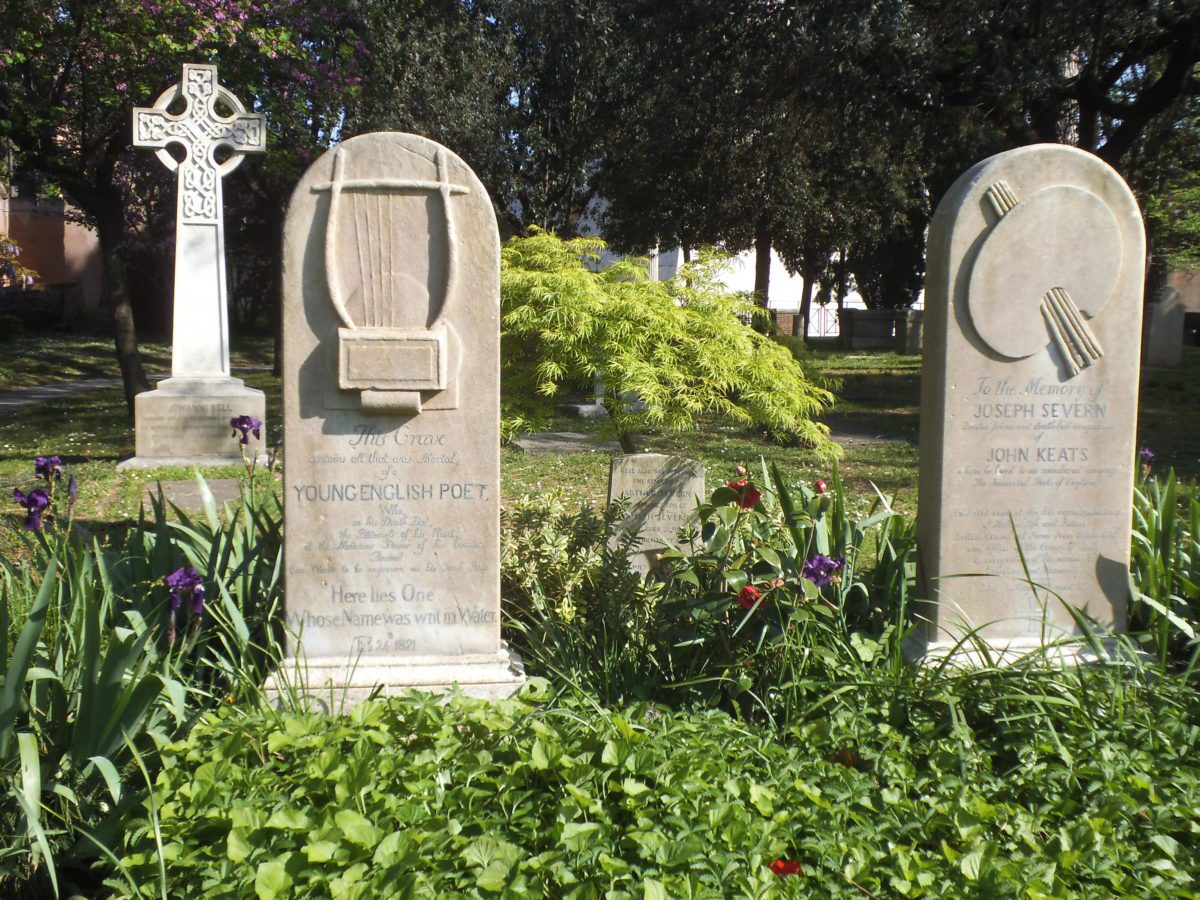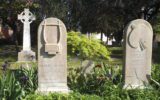It’s a must-see stop for anyone who is lover of Keats’s happenings and works. A walk through flowers and secular trees, will make you forget you are in a cemetery and will take you along a charming and unusual path.
We are in Rome. The Pyramid of Caius Cestius stands imposing itself, among the tombs of great artists and personality of the past, set through hedges and paths. The spectacular Pyramid, built between 18 and 12 BC, overhangs the Cemetery and makes its image even more mysterious and arcane. Caius Cestius, roman politician, in his will ordered the construction of a pyramid-shaped tomb to be completed in 330 days, otherwise would risk losing heritage from his descendants. The latter definitely less picky than their nowadays descendants, rather than lose the rich bounty, ended the spectacular Pyramid even several days before.
Those who stop at the Keats’s grave can admire its beauty and at the same time imagine the English amazed by such a charming landscape. Charlotte Anne Eaton (1788–1859), an English travel writer, in this way described her visit at cemetery in 1818: «the stillness and seclusion of the spot, the soft verdure of the earth, the ethereal brightness of the heavens, the grave of yesterday of our feet and proud tomb of the Roman that died eighteen centuries ago, backed by the dark battlements of the old walls of the city, – all were in harmony with the deep repose of the scene, and the hurt felt its melancholy beauty»… [1]
Melancholy beauty, because at the days of Keats the Cemetery was an open field, and as his friend Severn told in his letters, it contained about 30 graves. Nowadays, this green space of Cemetery refers to the early place of it, dated back to 700 – 800 th, and already since eighteenth century burying people was not allowed there. Melancholy beauty while watching this place we are inevitably are brought back to the roman concept of death, typically in North European, with lawns and beautiful carvings. Shelley who visited the Cemetery after Keats’s death, said: «It might make one in love with death to think that one should be buried in so sweet a place». [2]
It’s true. What immediately catches our attention and probably, unaware, deliver us a strange sense of inadequate serenity, is the total absence of photographs on the graves. The photos of departed, that observe and reminds us that death is inevitable for everyone inevitably, are not present here. The serenity we feel crossing paths studded with graves, seems to almost carry us in a higher dimension, a dimension of spirit, dimension that goes away the worldly one, reminded us by the images of the departed. In front of Keats’s grave there is a bench that invites us to listen to the language of nature.
Violets were Keats’s favourite flowers. Today, some of these shyly appear around his grave as a memory of his distant passion for these beautiful flowers. On his last days, Keats asked his dear friend Severn to visit the cemetery from him and bring back its description: «(…) he made me go to see the place where he was to be buried, and he expressed pleasure at my description of the locality of the Pyramid of
Caius Cestius, about the grass and the many flowers, particularly the innumerable violets, also about a flock of goats and sheep and a young shepherd — all these intensely interested him. Violets were his favourite-
flowers. He assured me: that he already seemed to feel the flowers growing over him»..[3]
Entering in early part of Cemetery, Keats’s grave is against the wall, in the most remote corner of the lawn. On his tombstone a lyre with broken strings is covered, on its bottom, the next epitaph says:
«This grave contains all that was mortal of a young English poet, who, on his death-bed, in bitter anguish at the neglect of his countrymen, desired these words to be engraven on his tomb-stone : ” Here lies one whose name was writ in water». – 24th February 1821.
These words bring to our mind Keats’s pains that constantly pervaded his life until his dead at the early age of 25 . In his life Keats suffered a lot because of the devastating reviews by his contemporaries, who did not don’t considered him a talented poet. The legend says that these devastating reviews killed him but it was not like that. The tuberculosis hunted his family and eventually reachedhim. Keats had a profound faith in his talent and he felt that one day he would be remembered in the pantheon of poets, but he would not tast its glory; he himself wrote: «I think I shall be among the English Poets after my death».[4]
Next to Keats’s tomb there is one of Joseph Severn, his faithful friend, who dispite the critics of friends and acquaintances, he treated him with devotion until his death. His tools-tablet and brushes are carved on his grave and below we can read the following inscription:
«To the memory of Joseph Severn devoted friend and death-bed companion of John Keats whom he lived numbered among the immortal poets of England »– died 3 august 1879
He died at the age of 86 after having been the most devoted of nurse throughout Keats’s sickness.
Our journey re-discovering John Keats goes on and takes us into the meanders of Keats’s pains. Before living the gate of the Cemetery, however, let’s stop just a little bit more and let’s take a look at the other tombs: we will discover beautiful works of art covered even now in all the world.
[1] CHARLOTTE A. EATON, Rome in the nineteenth century,. Edinburgh, Archibald Constable and C., 1820, Vol. II, p. 174
[2] In the Shelley’s preface to Adonais written in 1821
[3] A ADA FRANZETTI-GUASTALLA, John Keats, A. F. Formiggini, Editore In Roma 1922 – the Keats’s claim will be quote from Oscar Wilde in his poetry in honour of Keats (The Grave of Keats): «(…)Weave on his bones an ever-blossoming chain»..
[4] Letter to George and Georgiana Keats, October 14/15th, 1818 – (http://www.gutenberg.org/files/35698/35698-h/35698-h.htm#Page_168 )
Sources:
– Cimitero Acattolico, Guida romanzata del cimitero settecentesco di Roma, Iacobelli Edizioni 2011
– Keats-Shelly House, Guida , ed. Il Labirinto 2007
– Nuova Antologia di lettere, scienze ed arti, quinta serie, luglio-agosto 1912
– ADA FRANZETTI-GUASTALLA, John Keats, A. F. Formiggini, Editore In Roma 1922
– CHARLOTTE A. EATON, Rome in the nineteenth century, Edinburgh, Archibald Constable and C., 1820,Vol. II,. p. 174 (https://books.google.co.uk/books?id=q202AAAAMAAJ&pg=PA219&dq=%22the+many+faces+of%22&hl=en&sa=X&ei=q8quUo-jGqfY4wSd7IDYDg#v=onepage&q=174&f=false)























